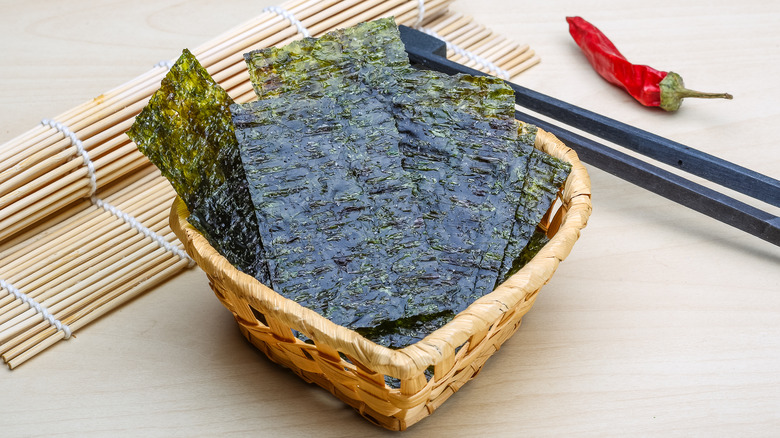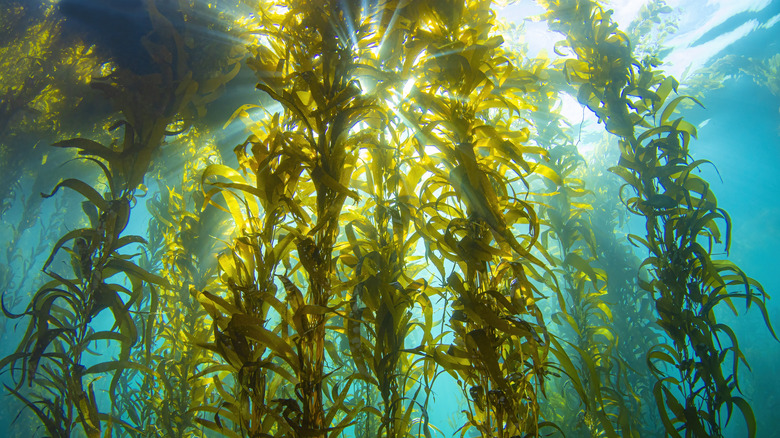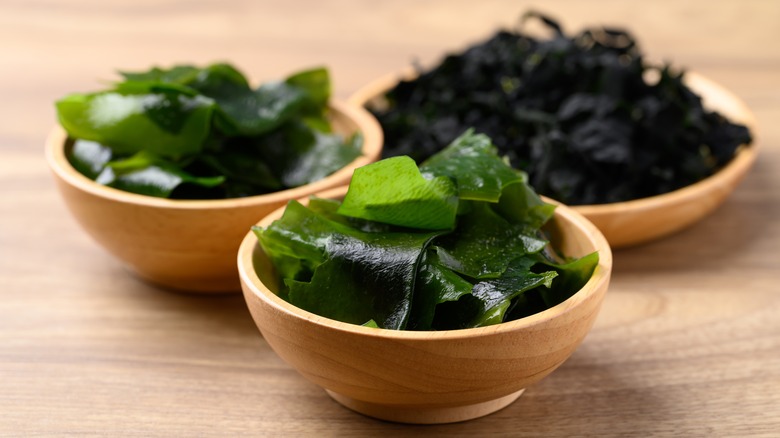What Makes Nori Different From Other Types Of Seaweed?
If you're looking for a guide to edible seaweed, a pretty accessible place to start is with nori. This salty, delicious sea vegetable is often found wrapped around sushi or onigiri, or packaged in small sheets as crunchy snacks. It's also cut into small pieces to be used in the spice blend furikake, which can be sprinkled over rice bowls or other dishes for a little umami punch.
Nori — which means "ocean moss" in Japanese — is produced from a type of red algae called pyropia, and has been part of the Japanese diet for over a thousand years. Though it was once eaten in its fresh form straight from the sea, drying it became a popular way to preserve this salty staple, and this dried form of nori grew to become the way it is usually eaten in modern Japan. Commercially sold nori is often roasted after drying to make it nice and crisp (at which point it is called yaki-nori), and it is sometimes flavored as well.
Though nori has a long history and a powerful culinary impact, it is far from the only type of sea vegetable used for food. Various types of edible seaweed differ according to the precise type of species they belong to, and how they might be used.
The different types of seaweed
What all types of edible seaweed have in common is their ability to add a salty, umami flavor to dishes, in Japanese cuisine and beyond. Seaweed tends to offer varied vitamins, minerals, and antioxidants. These sea vegetables can also be a sustainable food choice, as they may be farmed without much disturbance to the local ocean ecosystem. Edible seaweed varieties are also easy to forage for along many coastal areas around the world.
There are three main types of seaweed: red, green, and brown algae. These colors indicate where in the ocean they grow, according to their different photosynthesizing adaptations. Brown seaweed includes the subgroup known as kelp, which grows larger than any other type of seaweed, and of which kombu and wakame are two popular edible varieties.
However, sea vegetables called "brown kelp" or "brown seaweed" aren't always actually brown in color — just as nori, a type of red algae, appears green once dried. Depending on their preparation, some types of seaweed can even appear black (as with hijiki) or purple (as with ogonori, which is used to make agar agar — the basis for an astounding lamp that's good enough to eat). And while the different varieties all contain similar nutrients, brown seaweed has unusually high levels of iodine.
Wakame and nori
Though nori is what many Americans immediately picture when thinking about edible seaweed, other popular varieties offer their own pleasures. Wakame — which is commonly included in miso soup, and is the main ingredient in Japanese seaweed salad — is probably the best-known type of Japan's seaweed specialties after nori. Unlike nori, wakame is often packaged dry in thin, curly strips, but then rehydrated before eating, to produce chewy, slippery noodles of seaweed.
Another popular form of edible seaweed is kombu. A type of kelp which is farmed in Japan, Korea, and China, kombu is typically used to flavor soups and other dishes. Also sold dried in thick, brittle sheets, kombu is one of the primary ingredients in dashi — a foundation stock used in Japanese cooking. Dashi, which also contains bonito fish flakes, is made by soaking or simmering kombu before removing the rehydrated piece of kelp. Instant dashi, which contains powdered kombu, is also commonly sold in Japan. Kombu can also be cooked and eaten, or even stewed with beans or added to salads.



